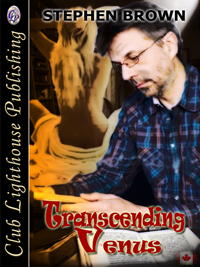NEW eBOOKS AVAILABLE IN 6 FORMATS
Adobe acrobat = PDF
HTML = .htm
Kindle = .mobi
MSReader = .lit
Nook = ePUB
PALM = .pdb
|
HOME >> Product 0454 >> The Maisonist>>

|

Touch image to enlarge
|
The Maisonist
Stephen Brown
When the day comes that you are tested, will you be equal to the challenge? Jon Jameson, investment advisor, has always wondered if he'd have the courage to rescue someone by racing into a burning building. Not that he's likely to be called on to do so. He leads an easy life: a good job, a beautiful wife and one financial indulgence. Jon collects houses. House collecting is an expensive hobby, but he's not greedy. A bit of patience, an eye for a good deal and careful negotiation will bring the collection together. The rent he collects from his small collection is re-invested, one hundred percent, to bring his properties to the state he believes they deserve. One hundred percent. Not one penny for anything else, not even for his wife, Frieda, who handles the day-to-day business of maintaining those properties. That is not what she signed up for.
|
$5.99
Paperback Buy Link
$8.00
|
|
When Jon's test comes it has nothing to do with burning buildings. One of his co-workers has crossed the line legally, and Jon is dragged down with him. Through no fault of his own, Jon Jameson is not only unemployed, he is unemployable. Frieda is not supportive. Jon screwed up. Jon can solve it. She continues to live and spend as usual, including her habit of purchasing twenty lottery tickets per week. While checking them for her, Jon discovers one worth sixty-million dollars. He should tell her, but they're not legally married. Frieda and her spoiled daughter getting rich while he remains a pauper? Unthinkable. He palms it.
Life becomes complicated. Frieda buys lottery tickets. Jon never does, and everyone knows it. How to claim it? He needs to get Frieda and her daughter to go away - far away. He also needs a junior partner, someone with enough nerve to cash the ticket and someone who won't arouse Frieda's suspicions when the winner's name hits the media. A real-estate agent he met once, Adriana Compote, seems perfect. She agrees. There's a lot of work to do, but they need to avoid any kind of contact until well after the ticket is cashed. They need a go-between and someone to do the leg work. Fife, the man who accidentally caused Jon's downfall, and who is just as unemployable, is brought on board. Adriana will collect the money, use it to create a high-end, real-estate company and then hire Jon as vice-president and Fife as manager. All three will draw overly-generous salaries (plus bonuses). What could go wrong?
Despite his desperate financial condition, Jon cannot get Frieda to leave. The morning of the day that Adriana is going to surrender the ticket, Frieda discovers a note from Jon to someone called "Adriana Compote", a name that will be all over the news by evening as a lottery winner who bought at the same kiosk and in the same quantity that Frieda did. Jon calls Fife and tells him to call it off, but it's too late. Adriana has already submitted the ticket. She sends back a message telling Jon to grow a pair and "handle it". He does.
To the surprise of the three conspirators, their business, Vintage Properties, makes money buying and renovating high-end houses. Jon looks forward to adding the best to his collection, which at the time consists of nothing, because he had to sell his modest collection to cover expenses. As a joke, a business acquaintance tells him about a mansion north of Toronto that "needs work".
The mansion is a ruin. Built at the end of the nineteenth century, it was the domain of Randolph Cranshaw a tyrant who liked to keep his wife and daughters isolated in a place where he had them under his control. Money came easily, but social status and a career in politics eluded him because of his reputation. Frustrated by those failures, Cranshaw poured his money into the house and, above all, into the extensive gardens that spread south to a cottage that he built to house a series of extra-marital affairs. Long after the era of the Cranshaws, a highway bypass cut the former estate in half. The rotting ruins of the mansion lie at the top of the north section. The cottage, still occupied, remains at the bottom edge of the severed southern part. The garden has gone wild for a century.
The decayed mansion is beyond rescue, but the cottage is in good shape. Nestled deep in the trees along a secluded lane, it calls out to Jon offering seclusion and safety. He feels the need for both, because he is being followed. Is it because of the lottery win or is it the unexplained disappearance of Frieda and her daughter? Perhaps leaving their bodies in the deep-freeze of a basement apartment wasn't the best long-term solution. He carries their frozen remains to the remote mansion property for burial but discovers that digging among trees is impossible; there are too many roots. Instead he buries them in the cellar of the mansion. The graves will remain undisturbed as long as the land remains a wood lot.
No sooner has the mansion been turned into a cemetery then a client turns up at Vintage Properties to ask about the property. Jon becomes even more paranoid. He convinces Fife to purchase the cottage property and rent it to him. Not only will it give him an untraceable place to rest, it will also allow him to keep an eye on the property to the north without attracting attention to himself by buying it. He investigates the history of the estate and concludes that the cottage was Cranshaw's love nest. More investigation turns up a name: Elizabeth Levisham.
Elizabeth first visited the Cranshaw estate at the age of fourteen. Five years later, at the age of nineteen, she appeared in a picture of a skating party on the garden pond. In the picture, Randolph Cranshaw stands behind her, smiling and with one hand resting on her shoulder. Mrs Cranshaw stands off to the side, not smiling. In nineteen twenty-nine, at the age of twenty three, Elizabeth stayed in the cottage for an extended period. When she left, a gossip column in the local paper commented that she would be "much missed" by the Cranshaws. The columnist was fired the next day. Despite an extensive search, Jon can find no record of Elizabeth Levisham after the day she left the cottage. He becomes suspicious that she never did leave...... .
|
|
Length:
|
57404 Words
|
|
Price:
|
$5.99
|
|
Published:
|
04-2018
|
|
Cover Art:
|
Stephen Brown
|
|
Editor:
|
W. Richard St. James
|
|
Copyright:
|
Stephen Brown
|
|
ISBN Number:
|
978-1-77217-081-8
|
|
Available Formats:
|
PDF; HTML; Microsoft Reader(LIT); Palm (PDB); Nook, Iphone, Ipad, Android (EPUB); Older Kindle (MOBI);
|
|
Paperback Price:
|
$8.00 Paperback Buy Link
|
|
|
MY HOUSE IS not haunted. If you spend the night you'll hear no muffled sighs. Ghostly visions will not pass through the walls. Furniture will not move on its own. No-one has ever complained about sensing a presence. Having cleared that up, there are a few things you should know. It's an old house, actually a cottage, and cottages have character. This one has more than its share. It was built, exactly in its present form, in nineteen twenty-two. "Caretaker's cottage" is the original description: one story, thick stone walls, two bedrooms (one large, one token), a bathroom, a sensible kitchen and a cozy front parlour with a wood stove and two tall windows that pass great shafts of sunlight in the morning. The roof is asphalt shingle, although in a different country a thatched roof would be more in character. The plumbing is ancient, but it works. The electrical is dodgy but not quite lethal. I've made upgrades to both although only as required. Every tradesman who comes in wants to gut the place and start from scratch. Not here. My cottage is special, as I have discovered the hard way, and it has to be handled carefully. I've learned to do that, and as a result I live a comfortable, although solitary, existence. This is a cottage for one person. That was the way the first owner designed it, although being alone here was never his plan.
The front yard is a square of well-kept lawn. Not a big square, just a nice fit to the size of the building. Between the lawn and the road (country lane) is a low, stone wall made of the same material as the cottage. The driveway curves so that you pull up right at the front door. It sounds pretentious for such a small place, but it is correct. That is the first thing that occurs to people when they visit. The proportions, the colour, the layout, all of them are right. This is a house that was crafted to seduce.
Now, about the back garden. You'll notice a decrease in my enthusiasm. There's a spotty bit of grass and a couple of lame flower beds, but those are just the bit outside the back door. The true garden lies beyond. First, it's huge. Not that you can tell by looking. The gnarled trees and tangled bushes in front hide the rest of it from sight, but it stretches all the way to the distant bypass that severed this oddly-shaped lot from the mother estate. Once it was a real garden, a spectacular garden, trust me, I know, but that was a hundred years ago. Want to know what happens when vegetation is allowed to go wild for a century? It's not pretty. Finding this cottage attached to this garden is like discovering that the sweet girl-next-door lives with a diseased serial killer.
|
|
To submit a review for this book click
here
|
|
|



|
|
|
|